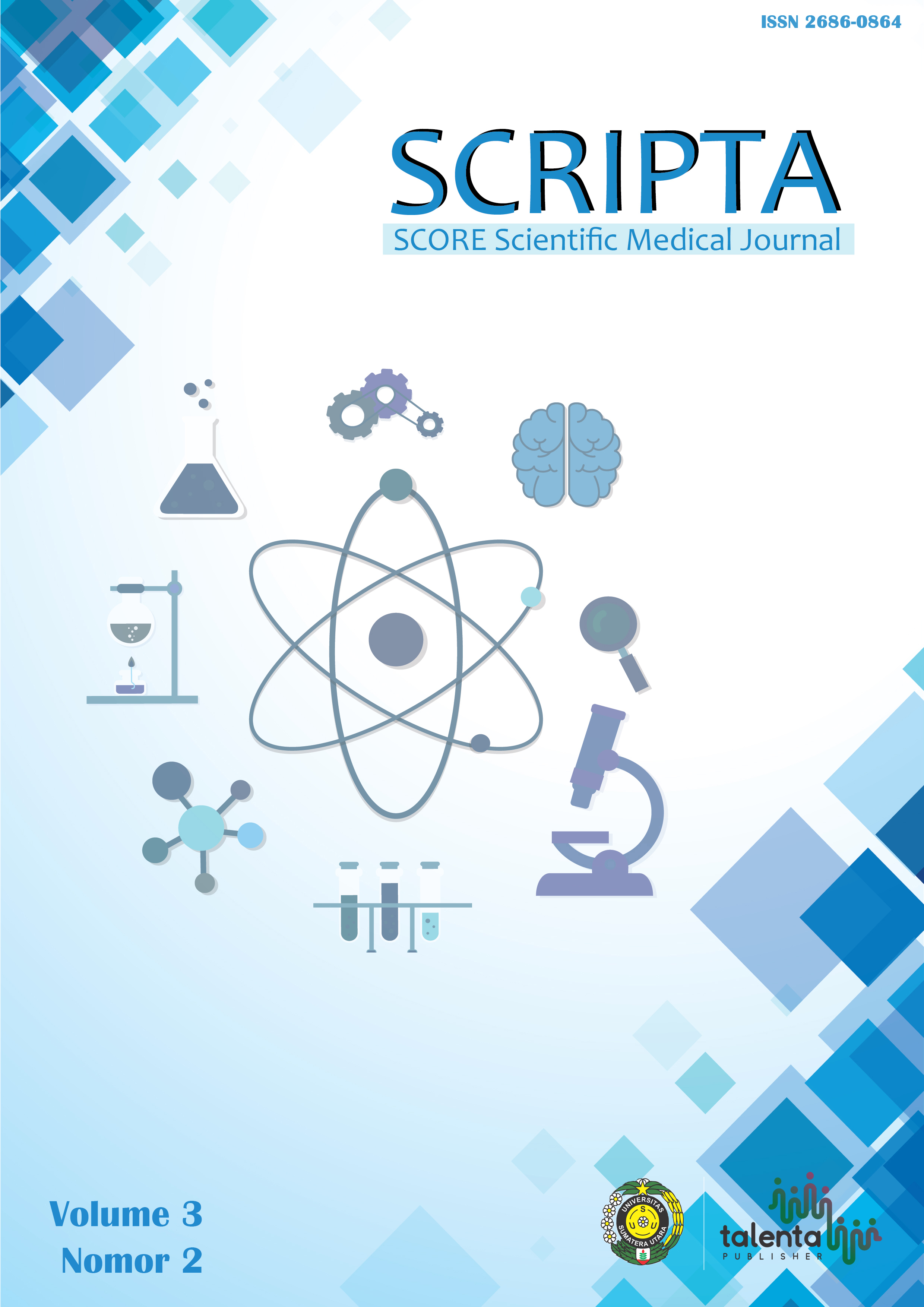Inhibitor Kanal Kv1.3: Ekstrak Racun Kalajengking spesies Heterometrus spinnifer (HsTX1) sebagai Terapi Potensial Lupus Eritematosus Sistemik (LES)
DOI:
https://doi.org/10.32734/scripta.v3i2.4538Keywords:
Heterometrus spinnifer , HsTX1, Kv1.3 channel, scorpion venom, Systemic Lupus Erythematosus (SLE) , kanal Kv1.3, Lupus Eritematosus Sistemik (LES), racun kalajengkingAbstract
Background: Systemic Lupus Erythematosus (SLE) is one of the most complex and common autoimmune disease. Current therapy is limited to symptomatic treatment which lead to disease relapse. The use of corticosteroids as immunosuppressant has many side effects. Long-term use of this drug can cause the occurrence of osteoporosis, which confers more risk since most of SLE patients are women. Animal venom is a potential substance for development of therapeutic modalities. One of the example of successful animal venom usage in therapy is captopril as anti-hypertensive agent.
Objectives: exploring the potential of scorpion venom as therapeutic modality for LES.
Methods: Analysis and synthesis of articles in the form of research paper and reviews relevant with the keywords Kv 1.3 channel, Systemic Lupus Erythematosus (SLE), dan Scorpion Venom.
Discussion: Inhibition of Kv1.3 channel by the peptides of scorpion venom has given new hope for the treatment of autoimmune diseases one of which is SLE. The channel is involved in most of the lymphocyte activation.
Conclusion: The utilization of scorpion toxins, especially the species of Heterometrus spinnifer (HsTX1), is expected to enlighten future developments of SLE treatment.
Keywords: Heterometrus spinnifer, HsTX1, Kv1.3 channel, scorpion venom, Systemic Lupus Erythematosus (SLE)
Â
Latar Belakang: Lupus Eritematosus Sistemik (LES) merupakan salah satu penyakit autoimun yang kompleks dan cukup sering ditemui. Terapi saat ini hanya sebatas pada pengobatan simtomatik dan bersifat sementara. Penggunaan kortikosteroid sebagai imunosupresan memiliki banyak efek samping. Penggunaan obat ini secara jangka panjang dapat menyebabkan terjadinya osteoporosis, terlebih LES umumnya diderita oleh wanita. Racun merupakan salah satu substansi yang potensial untuk digunakan sebagai modalitas terapi. Salah satu contoh keberhasilan pengolahannya adalah obat kaptopril yang berfungsi sebagai obat antihipertensi.
Tujuan: menggali potensi penggunaan racun kalajengking sebagai terapi LES.
Metode: Analisis dan sintesis dari artikel berupa research paper dan review yang relevan dengan kata kunci Kv 1.3 channel, Lupus Eritematosus Sistemik (LES), dan Scorpion Venom.
Pembahasan: Inhibisi kanal Kv1.3 oleh peptida racun kalajengking memiliki potensi sebagai terapi penyakit autoimun salah satunya adalah LES. Kanal tersebut terlibat dalam sebagian besar aktivasi sel limfosit.
Kesimpulan: Pemanfaatan kandungan racun kalajengking, khususnya spesies Heterometrus spinnifer (HsTX1), diharapkan dapat berkontribusi dalam pengembangan terapi LES di masa depan.
Kata Kunci: Heterometrus spinnifer, HsTX1, kanal Kv1.3, Lupus Eritematosus Sistemik (LES), racun kalajengking
Downloads
Downloads
Published
How to Cite
Issue
Section
License
Copyright (c) 2022 Yitzchak Millenard Sigilipu, Namira Assyfa Nurazizah, Nararian Padma Dewi

This work is licensed under a Creative Commons Attribution-ShareAlike 4.0 International License.
Authors who publish with SCRIPTA SCORE Scientific Medical Journal agree to the following terms:
- Authors retain copyright and grant SCRIPTA SCORE Scientific Medical Journal right of first publication with the work simultaneously licensed under a Creative Commons Attribution-NonCommercial License that allows others to remix, adapt, build upon the work non-commercially with an acknowledgment of the work’s authorship and initial publication in SCRIPTA SCORE Scientific Medical Journal.
- Authors are permitted to copy and redistribute the journal's published version of the work non-commercially (e.g., post it to an institutional repository or publish it in a book), with an acknowledgment of its initial publication in SCRIPTA SCORE Scientific Medical Journal.














